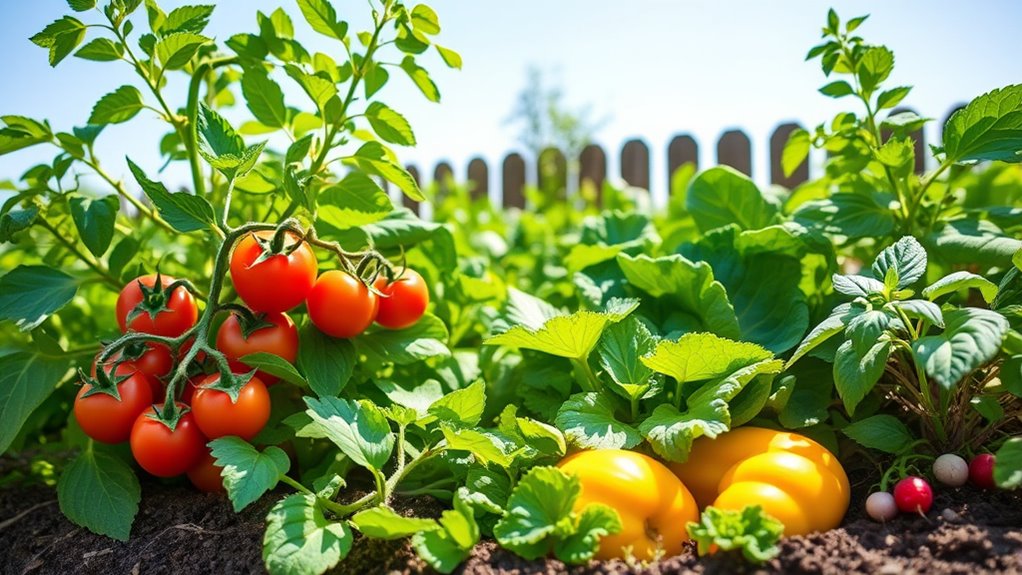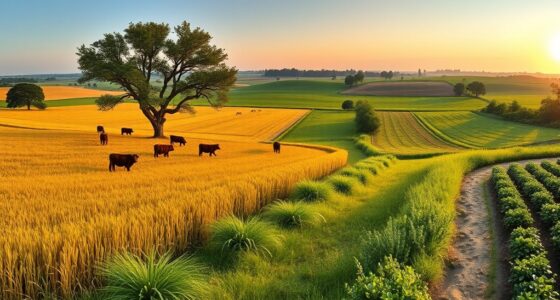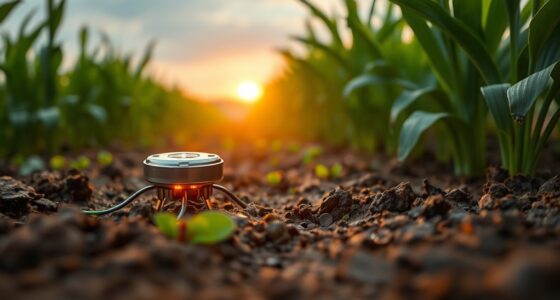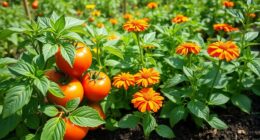If you're starting your gardening journey, consider these top 10 easy-to-grow crops: baby greens like arugula and kale, peas, green beans, cucumbers, radishes, parsley, squash, small fruited tomatoes, and potatoes. These crops are beginner-friendly, quick to harvest, and packed with flavor. They thrive in various conditions and require minimal effort to maintain. With each plant, you'll enjoy a rewarding experience and fresh produce. There's a lot more to discover about these wonderful crops!
Key Takeaways
- Baby Greens: Fast-growing and easy to sow, ideal for quick harvests in cool weather with multiple cuttings throughout the season.
- Radish: Quick to mature in 30 to 45 days, these easy-to-sow seeds thrive in cool conditions and offer flavorful roots and edible pods.
- Peas: A rewarding cool-season crop for beginners; easy to plant directly in the soil with minimal disturbance for early harvests.
- Green Beans: Versatile and simple, with quick germination and the ability to enrich soil nitrogen, making them great for crop rotation.
- Small Fruited Tomatoes: Fast-maturing and productive, they thrive in sunny spots and require minimal care in well-drained soil.
Baby Greens
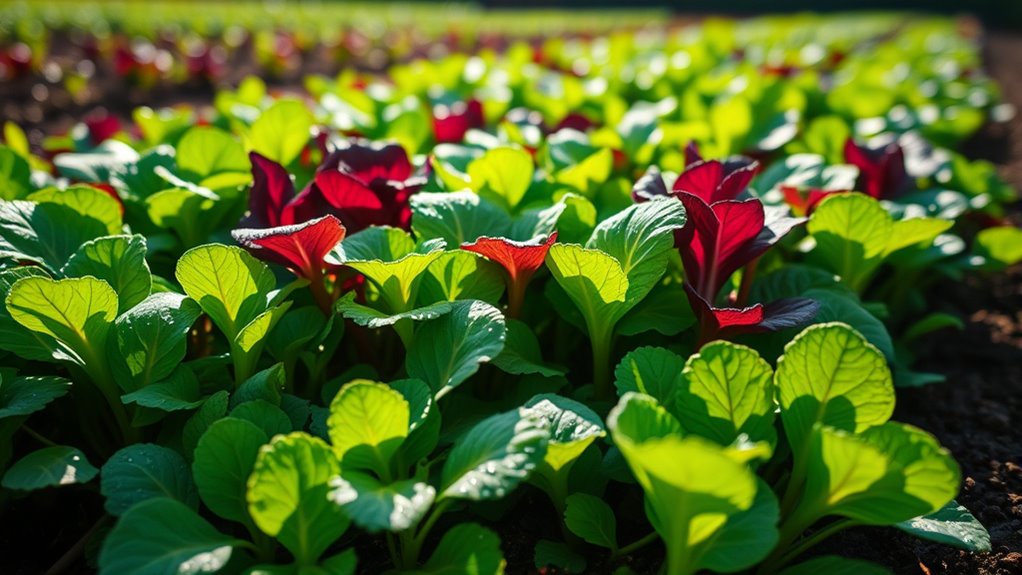
If you're looking for a rewarding crop to kickstart your gardening journey, baby greens are an excellent choice.
These fast-growing, easy-to-grow plants can be harvested within just 30 days, making them perfect for quick yields. You'll love how simple it's to sow the seeds—just scatter them without worrying about precise spacing.
Baby greens include a mix of delicious varieties like arugula, kale, and mustard greens, providing a diverse range of flavors and nutrients. They thrive in cool weather, so planting them in early spring or fall is ideal, helping you avoid pest pressures.
Plus, by regularly harvesting, you can enjoy multiple cuttings from the same plants throughout the season, maximizing your gardening efforts.
Peas
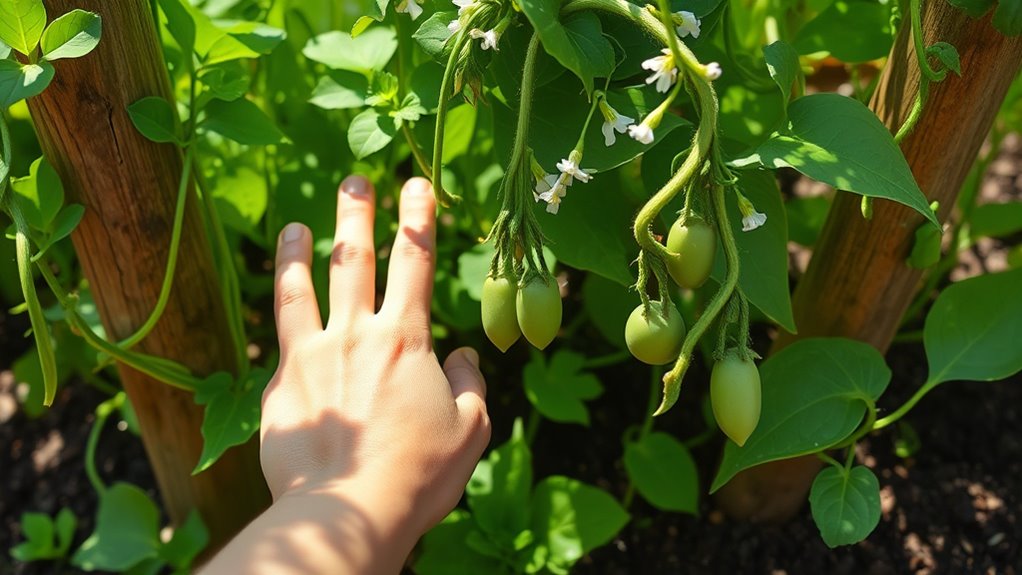
As you immerse yourself in your gardening adventure, consider planting peas, a rewarding cool-season crop that's perfect for beginners.
These easy-to-grow seeds are great for direct sowing in February or March, allowing you to enjoy an early harvest before summer heat sets in.
Plant peas in February or March for an early harvest before the summer heat arrives.
- Large seeds make for easy planting and handling.
- Minimal root disturbance is achieved through direct sowing.
- Support structures like trellises help maximize garden space.
- You can start harvesting snap peas as soon as 60 days after planting. Additionally, peas can benefit from companion planting, which enhances growth and pest resistance.
Green Beans
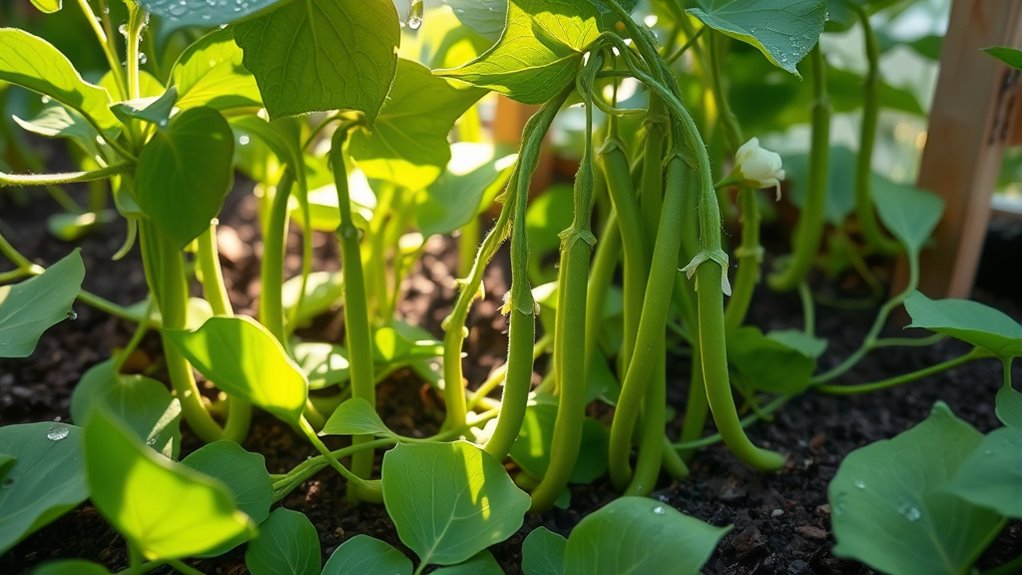
Green beans are a fantastic choice for beginner gardeners, offering both simplicity and versatility.
These easy-to-grow crops come in two types: bush beans, which don't need support, and pole beans, which thrive on trellises. They prefer warm soil, so plant them after the last frost date when temperatures hit at least 60°F.
Germination is quick, usually within 7 to 14 days, and you can expect a harvest in just 50 to 60 days. Regular harvesting encourages continuous production throughout the growing season, allowing for multiple sowings for a steady supply of fresh beans.
Plus, green beans enrich the soil with nitrogen, making them excellent for crop rotation and companion planting with other garden favorites.
Cucumbers
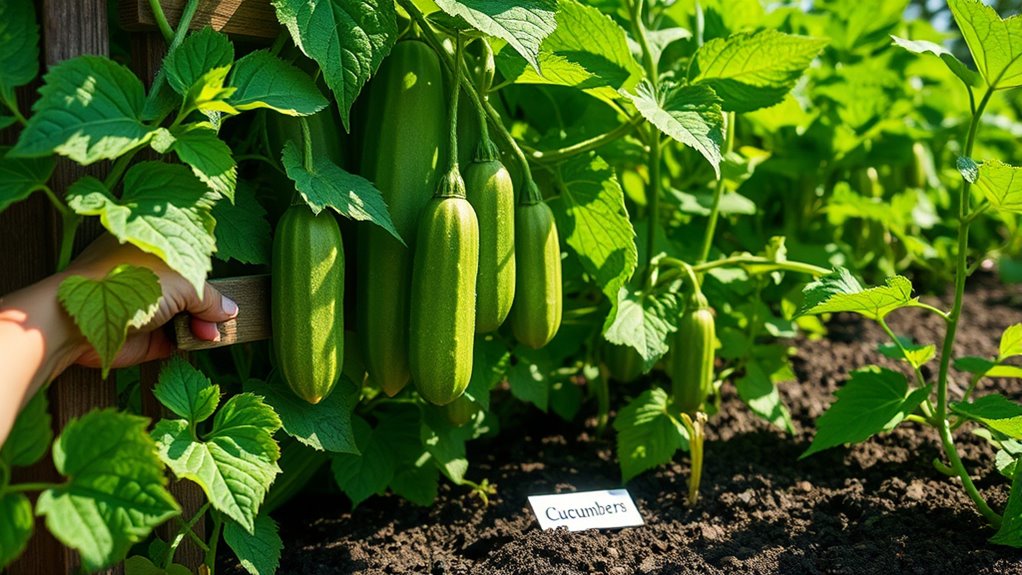
When you plant cucumbers, focus on direct sowing for the best results, as they don't handle transplanting well. To keep your plants healthy, consider using trellises for support and improved air circulation, while staying vigilant for pests. Incorporating anti-inflammatory benefits into your diet can also enhance your overall health and support your gardening efforts. With the right techniques, you'll enjoy a bountiful cucumber harvest in no time.
Planting Techniques
To successfully plant cucumbers, you'll want to wait until the soil temperature hits at least 60°F, guaranteeing ideal germination and growth.
Here are some effective planting techniques to take into account:
- Direct sowing: Plant seeds 1 inch deep and 12 to 18 inches apart in rows for maximum spacing.
- Treasure trellising: Support your cucumbers with trellises to promote healthier plants and easier harvesting.
- Water regularly: Make certain your cucumbers receive 1 to 2 inches of water weekly, especially during the fruiting stage, to prevent bitterness.
- Practice succession planting: Sow seeds every couple of weeks for a continuous harvest of this easy-to-grow crop.
These techniques will help you enjoy one of the easiest vegetables to cultivate in your garden!
Pest Management Strategies
Effective pest management is essential for growing healthy cucumbers, as pests can quickly undermine your efforts. Start by regularly monitoring your plants for common pests like aphids and cucumber beetles. Implement companion planting by adding marigolds and nasturtiums to deter pests while attracting beneficial insects.
Utilize row covers to shield young plants early on, ensuring light and moisture still reach them. Encourage natural predators, such as ladybugs, by planting diverse flowers nearby. If pests do appear, apply organic insecticidal soaps or neem oil promptly for safe and effective treatment. Additionally, consider incorporating sustainable harvesting practices to promote a healthier garden ecosystem.
| Strategy | Description |
|---|---|
| Companion Planting | Grow marigolds and nasturtiums to deter pests. |
| Natural Predators | Attract beneficial insects to maintain balance. |
| Organic Treatments | Use insecticidal soaps for safe pest control. |
Radish
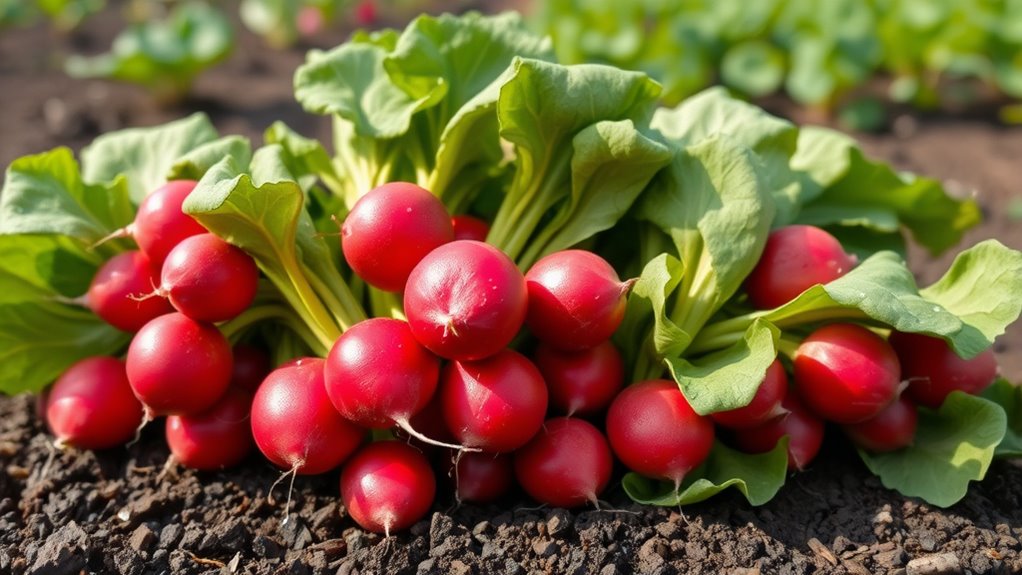
Radishes are perfect for beginner farmers because they grow quickly, usually ready to harvest in just 30 to 45 days.
You'll find that their larger seeds make sowing a breeze, allowing for easy planting right in your garden.
Plus, with a range of flavors from spicy to sweet, you can enjoy experimenting with different varieties in your meals.
Quick Growth Cycle
While many crops require a long wait before you can enjoy their harvest, radishes stand out with their remarkably quick growth cycle, maturing in just 30 to 45 days.
As one of the fastest-growing crops, they're perfect for beginner farmers looking for immediate gratification.
Here are some reasons to love growing radishes:
- Their larger seeds are easy to handle, making planting a breeze.
- They thrive in cool weather, ideal for early spring or fall sowing.
- You can harvest when roots reach marble to golf ball size for the best flavor.
- Edible seed pods can be pickled, adding extra value to your garden.
With their quick growth cycle, radishes are truly beginner-friendly!
Easy Sowing Techniques
After experiencing the joy of quick growth with radishes, it's time to focus on how to sow them effectively.
Start by selecting a cool season to plant, either early spring or fall. Radish seeds are large and easy to handle, so you can sow the seeds directly into your garden or raised beds.
Use easy sowing techniques like planting them in rows or simply scattering the seeds over the soil. Make certain to plant them about ½ inch deep for ideal germination.
Regularly water your radishes, especially during dry spells, to guarantee a good crop. With a growth period of just 30 to 45 days, you can enjoy multiple harvests throughout the season!
Flavor Varieties Available
When exploring the world of radishes, you'll find a delightful range of flavor profiles to suit your palate.
With so many flavor varieties available, you can easily choose what fits your taste. Here are some options to take into account:
- Spicy varieties: 'Daikon' and 'Black Spanish' pack a punch.
- Sweeter options: 'French Breakfast' and 'Cherry Belle' offer a milder taste.
- Unique colors: 'Watermelon Radish' not only tastes great but also adds visual appeal to salads.
- Edible seed pods: 'Rat Tail' provides a crunchy texture and milder flavor, perfect for stir-fries or salads.
Keep in mind that growing conditions can influence these flavors, making timing and care essential for the best harvest.
Basil
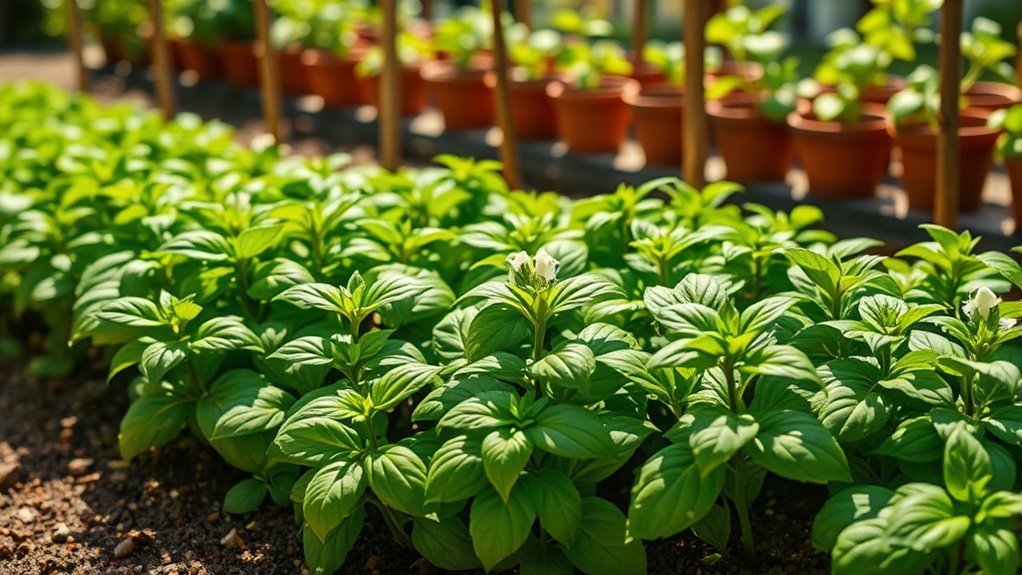
Basil is a fantastic choice for beginner farmers looking to enhance their garden with vibrant flavors and aromas.
Basil is an excellent option for novice gardeners wanting to bring rich flavors and delightful scents to their plots.
It's one of the easiest crops to grow, thriving in warm soil and adaptable to indoor or outdoor planting after the last frost. With a quick maturity of about 30 days, you can enjoy multiple harvests throughout the season.
Regularly pinching the leaves encourages bushier growth and improves leaf quality, making your basil plants even more productive. This versatile herb elevates dishes like pasta, salads, and pizzas with its aromatic flavor, adding both enjoyment and value to your vegetable garden.
Plus, basil acts as a natural pest deterrent, attracting beneficial insects that help protect your other crops. Additionally, natural pest deterrent properties of basil contribute to a healthier garden ecosystem by minimizing the need for chemical pesticides.
Parsley
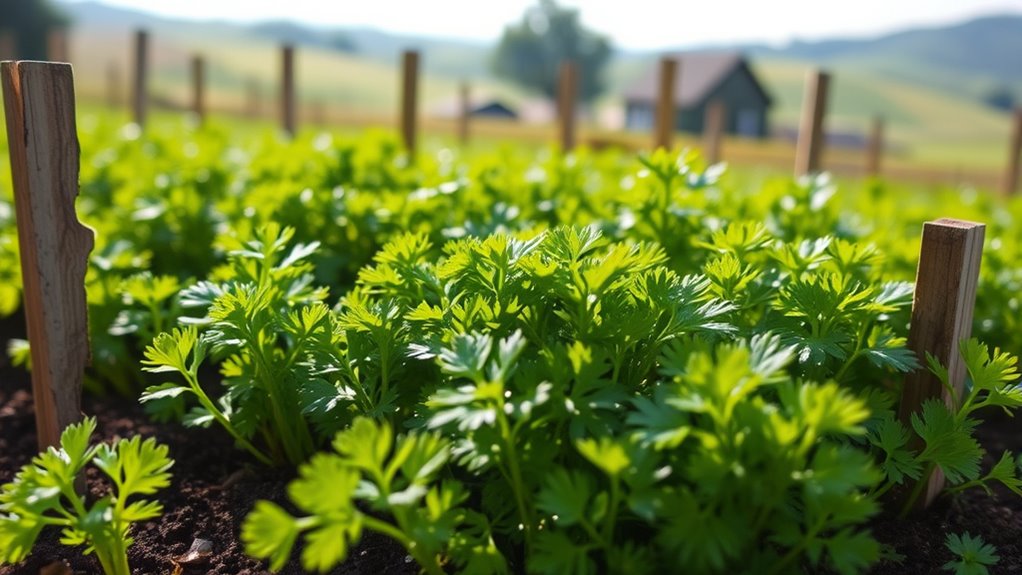
Though often overlooked, parsley is a must-have herb for any beginner farmer. This versatile biennial herb typically grows as an annual, producing lush leaves in its first year.
Here's what makes parsley a great choice:
- Nutritious: Packed with vitamins A, C, and K.
- Well-drained Soil: Thrives in well-drained soil, ensuring healthy growth.
- Spring Planting: Ideal for spring planting, it flourishes in cool to mild temperatures.
- Regular Harvesting: Encourages new growth and prevents bolting.
You can start parsley from seed or buy transplants. Seeds germinate in about 2 to 3 weeks, and soaking them beforehand boosts sprouting rates. Additionally, parsley juice is rich in vitamins and acts as a natural diuretic, enhancing its health benefits.
With consistent moisture and care, you'll enjoy a continuous supply of fresh parsley throughout the growing season.
Squash
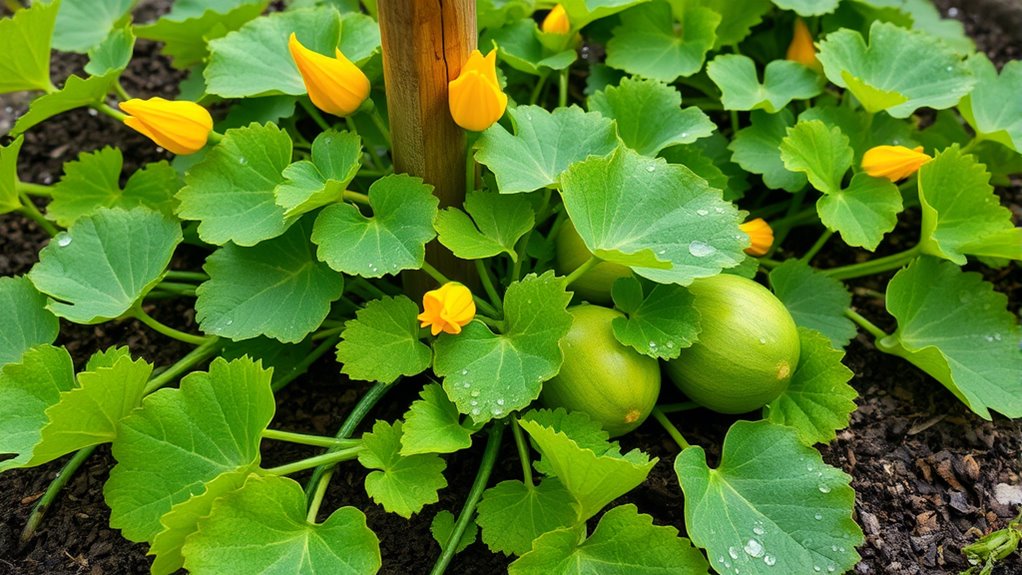
If you're looking for a rewarding crop, squash—especially summer varieties like zucchini—should be at the top of your list. These crops for beginners are highly productive, often yielding abundant harvests just two months after planting.
To get started, plant squash directly into warm soil, ideally when temperatures reach at least 60°F, as they don't transplant well. You can grow squash in various spaces, including raised garden beds, containers, or directly in the ground.
Regular watering is essential during flowering and fruit development to promote robust growth and avoid issues like blossom end rot. Plus, managing pests and diseases, such as powdery mildew, is manageable through crop rotation and replanting, making squash an excellent choice for your garden. Educational toys, like those that support cognitive growth, can also help children understand the importance of gardening and plant care.
Small Fruited Tomatoes
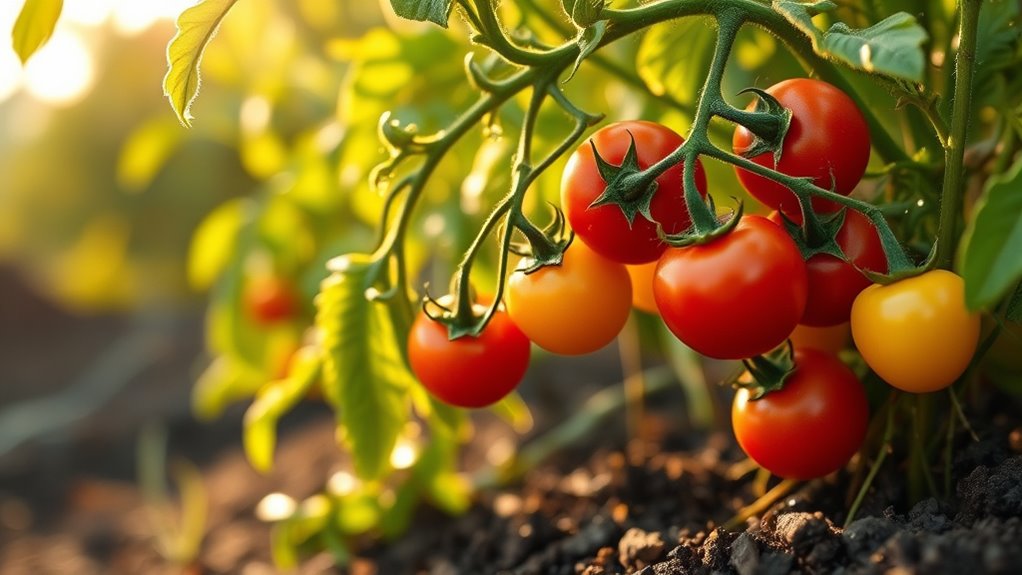
Small fruited tomatoes, like cherry and grape varieties, are perfect for beginner farmers because they're easy to grow and yield plenty of fruit.
You'll find that these plants thrive in sunny spots and can even be grown in containers if space is tight.
With a few simple cultivation techniques, you'll be well on your way to a rewarding harvest. Additionally, using self-watering pots can help maintain consistent moisture levels, promoting healthier plant growth.
Easy Cultivation Techniques
As you commence on your gardening journey, consider cultivating small fruited tomatoes like cherry and grape varieties. These plants are perfect for beginners thanks to easy cultivation techniques that boost your confidence. They mature quickly, often ready to harvest in just 60-70 days.
- Make certain they receive 6-8 hours of sunlight daily.
- Use well-drained soil and maintain consistent moisture.
- Trim small leaves to improve air circulation and reduce disease risk.
- Regular harvesting encourages ongoing fruit production.
With their lower energy requirements and resistance to common issues, small fruited tomatoes make gardening enjoyable. You'll love watching your plants thrive and produce delicious fruits, extending your growing season and enhancing your experience!
Varieties for Beginners
A variety of small fruited tomatoes can make your gardening experience both rewarding and enjoyable.
These tomatoes, including cherry, grape, and plum varieties, are some of the easiest to grow, thanks to their lower energy requirements for fruit production. They mature faster, giving you an earlier harvest that boosts your confidence as a beginner.
Plus, their resistance to diseases and pests means you're likely to see success, regardless of your gardening conditions. You can grow small fruited tomatoes in containers or directly in your garden, which is perfect if you're short on space.
Regular harvesting encourages continuous fruit production, ensuring a bountiful supply throughout the season.
Get ready to enjoy fresh tomatoes with minimal effort!
Potatoes
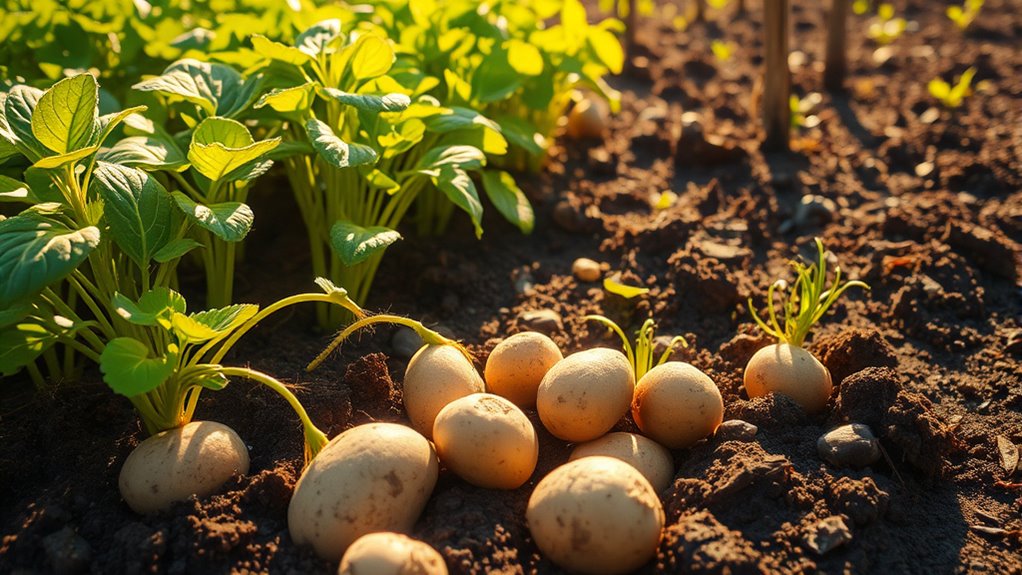
Potatoes are a fantastic choice for beginner farmers looking to grow a reliable and rewarding crop.
Potatoes offer beginner farmers an easy and fulfilling crop to cultivate successfully.
They're easy to plant and cultivate, making them perfect for your first gardening experience.
Here are some key points to take into account:
- Use seed potatoes with eyes for sprouting.
- Make certain your soil is well-drained and has a pH of 4.8 to 5.4.
- Harvest can occur in 70 to 120 days, depending on the variety.
- Keep soil consistently moist, especially during tuber formation. Additionally, ensure that your planting area has access to nearby water to support healthy growth.
Frequently Asked Questions
What Is the Best Crop for a Beginner Farmer?
If you've ever watched a neighbor effortlessly grow vibrant peas in their garden, you might wonder what crop's best for you as a beginner farmer.
Snap peas are a fantastic choice. They're easy to sow directly in your garden, thrive in cooler weather, and you'll see results quickly.
With minimal care, you'll enjoy a bountiful harvest in no time, boosting your confidence and encouraging you to try more crops in the future.
What Is the Easiest Crop to Grow?
When you're looking for the easiest crop to grow, lettuce is a fantastic choice. You can sow it directly or start it indoors, and it thrives year-round.
Plus, you'll enjoy quick harvests by picking off the outer leaves.
Radishes are another great option, maturing in just 30-45 days.
If you're after something like green beans, they germinate quickly and do well in poor soil.
Whatever you choose, you'll have a rewarding experience!
What Is the Easiest Vegetable to Grow for Beginners?
If you're looking for the easiest vegetable to grow, lettuce is a fantastic choice. You can sow it directly in the ground or start it indoors, and it offers a variety of shapes and colors for continuous harvesting.
Radishes are another great option since they mature quickly in just 30-45 days.
Green beans also thrive in poor soil and are simple to cultivate, making them perfect for beginner gardeners like you.
What Is the Cheapest Crop to Grow?
Cost-conscious cultivators often find radishes to be the cheapest crop to grow.
With their quick maturation of just 30-45 days, you can enjoy multiple harvests in a single season. Their low-cost seeds make them an economical choice, perfect for your gardening budget.
Plus, you can sow them directly into the soil, eliminating the need for expensive equipment.
Conclusion
So, whether you're planting your first seeds or just looking to expand your garden, these easy-to-grow crops are perfect for you. They'll thrive in your backyard just like the latest smartphone thrives in your pocket! By starting with baby greens, peas, and other beginner-friendly options, you'll build confidence and enjoy a bountiful harvest. Get your hands dirty, embrace the journey, and soon enough, you'll be reaping the rewards of your hard work. Happy farming!

